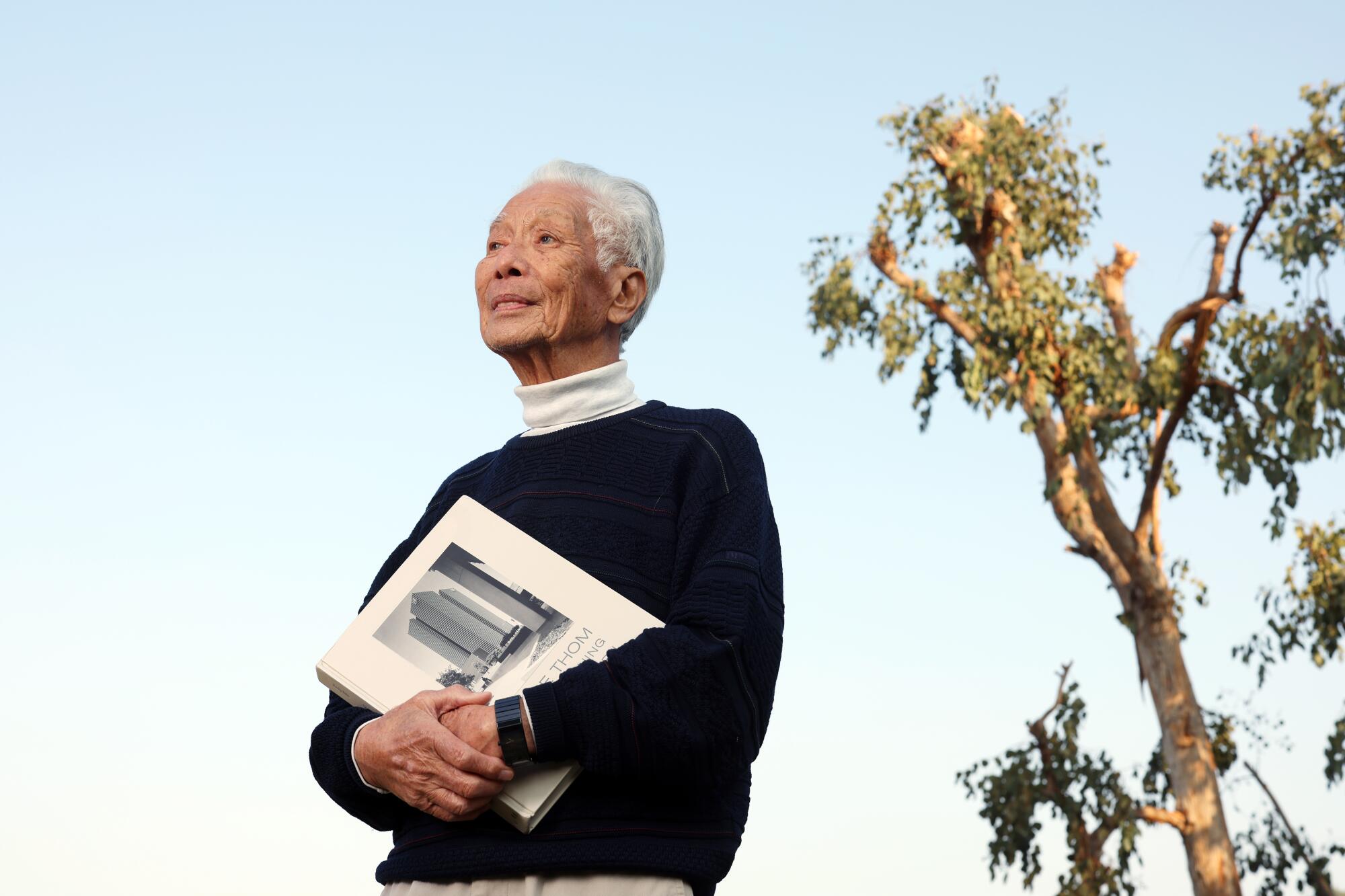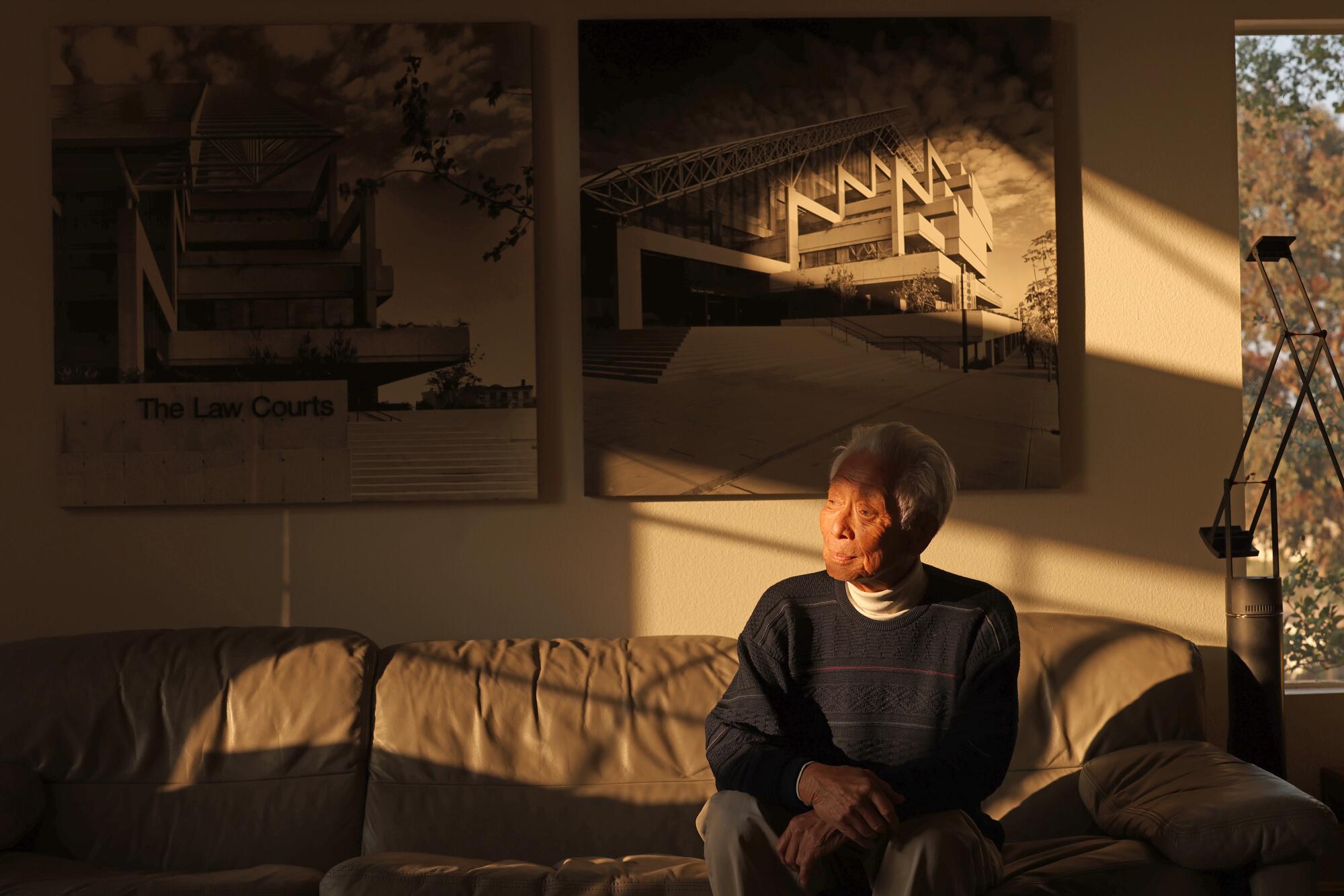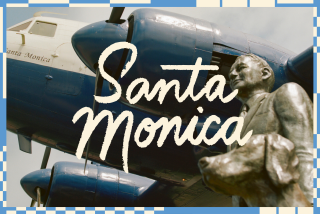
Architecture photographer Wayne Thom lived at the Bonaventure hotel for a week in 1977 as preparation for taking one of his most iconic images. To shoot the sculptural elegance of John Portman’s building, Thom woke at 4 a.m., positioned himself on the offramp of the 110 Freeway and readied to catch the sunrise. In the resulting photograph, the hotel’s cylindrical forms rise Oz-like from downtown Los Angeles, the curved facades reflecting the colors of dawn.
“I light the building with sun behind it, which illuminates the clouds,” Thom said when asked how to capture the dazzle of mirror glass. Retired and living with his wife, Aesook Jee, in the San Gabriel Valley community of Rowland Heights, 87-year-old Thom still approaches his craft with well-honed technique and poetry in equal measure. “You are photographing the reflection, not the building. The building is just a frame for the reflection of the sky.”
His composition depicts a futurist utopia, with hints of dystopia. Nearby buildings are shrouded in shade, and the freeway is eerily empty. Such is the L.A. of the 1970s, equal parts sci-fi optimism and vérité. It’s a period that architecture historians call Late Modernism, a time of sprawling urban growth set against social change.
Thom’s career began in 1968, and his work chronicles the ambitious projects — from university campuses to skyscrapers — of significant architecture firms of Late Modernism, landmarks like Charles Luckman Associates’ monumental Inglewood Civic Center (1973), the tall and streamlined Security Pacific National Bank by AC Martin and Associates (1974, now called Bank of America Plaza) and DMJM’s drum-like luxury towers at the Marina City Club Condominiums in Marina del Rey (1971).
The new Monacelli Press book “Wayne Thom: Photographing the Late Modern” is dedicated to this expansive period. The volume covers the first 20 years of the photographer’s practice and draws on Thom’s archive at the USC Libraries. Acquired in 2015, the archive holds some 2,603 projects and more than 2 million color or black-and-white transparencies.
The book’s Los Angeles-based author, architecture historian Emily Bills, noted that Southern California’s built environment changed in three major ways in the late ’60s to early ’80s: L.A. went vertical after height limits were overturned in the 1950s, seen most clearly along Wilshire Boulevard and on Bunker Hill; Orange County transformed from citrus fields to corporate office parks; and California’s higher education system exploded, requiring new buildings and master plans. “Wayne’s the photographer for that changing scene,” Bills said.
Born in Shanghai in 1933, Thom grew up comfortably in Hong Kong. During the British colony’s occupation by Japan during World War II, Thom and his family fled to the mainland Chinese city of Kunming with the help of the Canadian embassy (Thom’s father was a Canadian citizen). They eventually moved back to Hong Kong and Thom became obsessed with photography, going as far as to transform a bathroom in his parents’ house into a darkroom on Saturdays.
When Thom was 17, his father relocated the family to Vancouver. Thom’s brother, Bing, studied architecture and worked for Canadian architect Arthur Erickson before going out on his own.
Thom kicked around the West in his 20s. He drove a delivery truck in Sacramento for his aunt and uncle and was a ski instructor in the Canadian resort town of Banff. Yet photography stuck with him.
“I was a ski bum,” Thom said with a laugh. “One day I was teaching skiing in Banff, I realized that I couldn’t do this forever.”
Wanting to be back in California, he enrolled first at ArtCenter College of Design in Pasadena, then transferred to Brooks Institute in Santa Barbara in search of more specialized training.
After graduating, Thom landed in Los Angeles, determined to build a practice. Modernist architect A. Quincy Jones gave him his first big break. Impressed by Thom’s skill and eye, Jones introduced the young photographer to notable design directors at local firms: Thornton Ladd of Ladd & Kelsey and Gin Wong at William L. Pereira & Associates.
However, his arrival coincided with the domination of two famous architecture photographers: Marvin Rand and Julius Shulman.
“Wayne delayed coming to L.A. until he had a solid portfolio because he knew he had to compete with these guys,” Bills said.
But even established photographers had to adapt to the transforming urban landscape. “One of the things I’m really good at is shooting high rises,” Thom said. “Julius Shulman never photographed anything much taller than three-story buildings.” In Late Modern L.A., height matters.
Skyscrapers are notoriously difficult to shoot. Getting the right perspective on a 40-story tower takes technique and guts. Ambitious and dashing, Thom would do anything to get the shot. He’d charm his way onto the roof of a nearby office building, bribe a window washer to let him use a rig or rent a helicopter — leaning out the cockpit with a heavy lens.
Thom defines architecture photography as the nexus of color, form, texture and shape, and the resulting work displays an exactitude for engineering and materials. He’d often ask architects to walk with him as he worked — and to carry his camera bag as they explained their intentions. Thom’s images of the Transamerica Pyramid (1969) by Pereira & Associates, taken early in his career, demonstrate his commitment to understanding architecture. In one photo, the 43-story tower rises from a diagrid superstructure, light and shadow alternating on each facet. Seemingly tiny cars and people accentuate the robust scale. In another, the pyramid is fully illuminated from within and set against a blue-black night. A glowing, impossibly narrow point inscribes itself firmly on San Francisco’s skyline.
“The high-rise building is related to nature. It reminds me of the mountains and the trees,” said Thom, thinking about his ongoing hobby: nature photography. “When I look at the ridge of the Rockies and the verticals of the trees, I see a skyline. Looking at a high-rise building is like walking in a forest. It’s functional sculpture.”

More to Read
The biggest entertainment stories
Get our big stories about Hollywood, film, television, music, arts, culture and more right in your inbox as soon as they publish.
You may occasionally receive promotional content from the Los Angeles Times.










